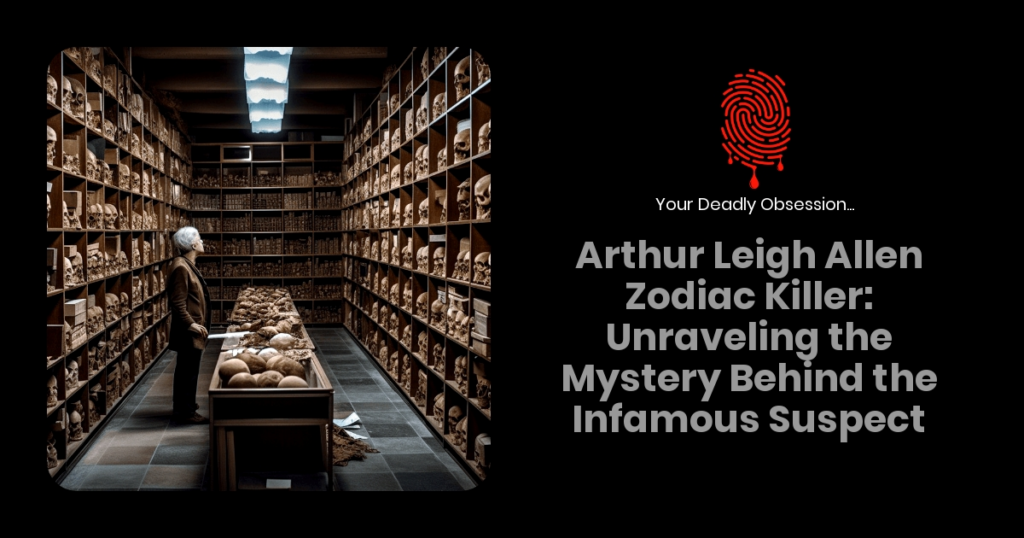The Arthur Leigh Allen zodiac killer mystery has captivated American culture for decades. As we delve deeper into the unsettling story of this enigmatic serial killer, it becomes apparent that there is still much to uncover. From chilling, coded messages sent to newspapers to the brutal and seemingly random murders, the Zodiac Killer has kept investigators and the public on the edge of their seats for years, with Arthur Leigh Allen being one of the prime suspects at the center of it all.

While the Zodiac Killer terrorized Northern California in the late 1960s and early 1970s, there’ve been numerous suspects linked to these horrifying crimes, but Arthur Leigh Allen is perhaps the most well-known. His name has become synonymous with the case due to several pieces of circumstantial evidence, as well as a number of suspicious claims from Allen himself. Despite the fascination with Allen, there has yet to be conclusive evidence connecting him to the Zodiac crimes.
As we explore the enigma that is Arthur Leigh Allen, it’s important to recognize the impact this harrowing case left on society. From inspiring novels, films, and documentaries to leaving a mark on the psychology of the American public, the events surrounding the Zodiac Killer and Arthur Leigh Allen have become more than just an unsolved murder case – they have shaped the way we think about the darkness lurking in our own backyards.
Arthur Leigh Allen: Prime Suspect
Arthur Leigh Allen has long been considered the prime suspect in the infamous Zodiac Killer case. We’ll explore some of the reasons why he garnered the focus of law enforcement and intrigued true crime enthusiasts for decades.
Born in Honolulu, Hawaii on December 18, 1933, Allen had a troubled upbringing. He faced multiple issues in his early life, including:
- Being expelled from the U.S. Navy in 1958
- Losing his teaching job in 1968 due to accusations of sexual misconduct and suspicion of child molestation
- Arrests for armed robbery, assault, and possession of a silenced automatic weapon
The investigation into Allen as the Zodiac Killer gained momentum in the 1970s. Several factors contributed to this suspicion:
- Physical description: The Zodiac Killer’s physical description, as provided by witnesses, closely matched that of Allen, who was a large white male with a stocky build.
- Cryptic letters: Allen was known for creating encrypted messages and had an interest in cryptograms, which were part of the Zodiac Killer’s MO.
- The watch: A friend of Allen, Don Cheney, claimed Allen showed him a wristwatch featuring the brand name Zodiac and the crossed-circle symbol before the killer’s murders began.
- Ciphers found in Allen’s possessions: When police searched Allen’s trailer, they discovered code symbols identical to those used by the Zodiac Killer.
- Conversations: Cheney stated that during a conversation in 1968, Allen mentioned his idea of using a flashlight attached to a gun, which was used in the Zodiac Killer’s attack at Lake Berryessa.
However, there were also pieces of evidence pointing away from Allen. Key issues included:
- Handwriting: Allen’s handwriting did not match samples from the Zodiac Killer, although experts considered it possible he could have disguised his handwriting.
- DNA: The most recent DNA analysis from stamps and envelopes tied to the Zodiac Killer did not match Allen’s DNA.
Despite these inconsistencies, the case against Allen persisted, and he remained a significant person of interest until his death in 1992. The unsolved nature of the Zodiac Killer case continues to fascinate crime enthusiasts and leaves Arthur Leigh Allen as an ever-present figure in its history.
Diving into the Evidence
We’ll kick off this section by examining the key pieces of evidence that have led some to suspect Arthur Leigh Allen as the Zodiac Killer. There are several factors to consider when assessing Allen’s potential involvement in this infamous crime spree:
- Fingerprints and handwriting: Although Allen’s fingerprints never matched those left at Zodiac crime scenes, the investigators couldn’t entirely dismiss Allen as a suspect. It’s important to note that Allen’s handwriting samples did not match the Zodiac letters, but some argue this may not be conclusive evidence due to the possibility of the Zodiac using a disguised writing style.
- Suspect descriptions and physical evidence: Witnesses provided descriptions of the Zodiac Killer that, in some cases, resembled Allen. However, there were inconsistencies among these descriptions. The composite sketch, based on eyewitness reports, bears some resemblance to Allen, but it’s far from an exact match. Additionally, a shoe print size of 10.5, found at one of the crime scenes, was similar to Allen’s shoe size.
- Statements from people who knew Allen: Some acquaintances of Allen have made claims about his potential involvement in the Zodiac murders. One such individual, a former friend named Don Cheney, asserted that Allen admitted to wanting to kill people and sign the crimes with a symbol resembling the Zodiac’s. Though intriguing, these statements vary in credibility and reliability.
- The Zodiac wristwatch: Allen owned a Zodiac brand wristwatch, which featured the symbol used by the Zodiac Killer in his letters. This coincidence caught the attention of investigators, but it’s important to remember that owning such a watch doesn’t necessarily imply guilt.
- Questionable alibi: Allen provided an alibi for the day of one of the murders, claiming to be scuba diving in Monterey. However, this alibi has been considered weak by some due to the lack of witnesses to corroborate his story.
To summarize the key evidence regarding Arthur Leigh Allen:
| Evidence Type | Details |
|---|---|
| Fingerprints | No match found |
| Handwriting | No match found |
| Suspect Descriptions | Inconsistencies and partial resemblance to Allen |
| Statements from Acquaintances | Claims of Allen’s involvement, varying in credibility |
| Zodiac Wristwatch | Allen owned a Zodiac brand watch |
| Questionable Alibi | Weak, uncorroborated alibi for one of the murders |
It is crucial to approach this investigation with caution and not make hasty conclusions. While the evidence we’ve reviewed may hint at Arthur Leigh Allen’s potential connection to the Zodiac Killer, it’s essential to weigh this information against the lack of definitive evidence.
Next, we’ll explore the circumstantial evidence that has contributed to the ongoing debate surrounding Allen’s potential involvement. This type of evidence, while not entirely conclusive, can add valuable context to help paint a broader picture of Allen and his possible connection to the Zodiac murders. Key factors include:
- Allen’s criminal record: He had prior convictions for child molestation.
- His knowledge of weapons: Allen was a former naval officer and had experience with firearms.
- The absence of Zodiac letters: The Zodiac letters abruptly stopped around the time of Allen’s death in 1992.
In the end, while these pieces of evidence are noteworthy, they don’t lead to a concrete conclusion. The case of Arthur Leigh Allen as the potential Zodiac Killer remains inconclusive and continues to fascinate true crime enthusiasts worldwide.
Controversial Letters and Cryptograms
We must not overlook the controversial letters and cryptograms that surround Arthur Leigh Allen and the Zodiac Killer case. These communications added a layer of mystery and intrigue to the unsolved murders, captivating the attention of both law enforcement and the public.
The Zodiac killer sent a series of letters to newspapers during his murder spree. In these letters, he claimed responsibility for the killings, taunted law enforcement, and even demanded that his letters be published on the front page. The letters were signed with a unique symbol resembling a cross and circle, which became the killer’s signature. Allen’s handwriting, however, did not match the writing in the Zodiac letters.
Besides the letters, cryptograms were another key aspect of the Zodiac Killer case. The killer sent several coded messages, with the most famous being:
- The 340-character cipher (unsolved for over 50 years but cracked in December 2020)
- The 408-character cipher (solved in 1969)
- The 32-character ‘My Name Is’ cipher (still unsolved)
Although the 340-character cipher and the 408-character cipher were deciphered, they did not reveal the killer’s identity. On the other hand, the unsolved ‘My Name Is’ cipher is believed to contain the killer’s name, but its short length makes it difficult to crack.

As for Allen’s connection to the cryptograms, there is no direct evidence linking him to the creation of these ciphers. It’s worth noting that Allen was a Navy veteran with a background in cryptography, but that alone isn’t enough to place him as the mastermind behind the cryptograms. The inability to definitively link Allen’s handwriting to the Zodiac letters and the lack of evidence connecting him to the ciphers further complicates the case against him as the Zodiac Killer.
In the end, the controversial letters and cryptograms associated with the Zodiac Killer case provide intriguing pieces to the puzzle without giving definitive answers. With no concrete evidence linking Allen to these communications, the mystery around the killer’s identity remains unresolved, keeping our fascination with the Zodiac case alive.
Did Arthur Leigh Allen wear a Zodiac watch?
Yes, Arthur Leigh Allen, a primary suspect in the Zodiac Killer case, was known to own and wear a Zodiac brand watch. The watch featured a crossed-circle symbol similar to the one used by the Zodiac Killer in his communications.
Did Mike Mageau identify Arthur Leigh Allen?
No, Mike Mageau did not identify Arthur Leigh Allen as the Zodiac Killer. Mageau, a survivor of one of the Zodiac attacks, identified another suspect, but there has been no direct link or definitive evidence connecting Allen to the Zodiac crimes.
Conclusion: Was Allen Really Zodiac?
Throughout our investigation into Arthur Leigh Allen as the Zodiac Killer, we’ve encountered numerous pieces of evidence, both supporting and contradicting his possible involvement. As with many cold cases, there are still unanswered questions, and the mystery continues to intrigue us all.
In Allen’s favor, there were some strong points indicating he could be a prime suspect:
- Strong physical resemblance to police sketches of the Zodiac Killer
- Possession of Zodiac-associated objects, such as a Zodiac brand wristwatch
- Being one of the few left-handed suspects
- His expertise with firearms and codes
However, it’s essential to address the information that casts doubt on Allen’s involvement:
- Lack of direct physical or definitive forensic evidence connecting him to any crime scenes
- DNA evidence from the crime scenes not matching Allen’s genetic profile
- Handwriting analysis that excluded him as the author of the Zodiac letters
So, as die-hard mystery and crime fans, are we satisfied that Arthur Leigh Allen was the infamous Zodiac Killer? Despite the many intriguing connections and pieces of circumstantial evidence, a lack of definitive proof prevents us from drawing a solid conclusion. The question of whether Allen was truly the Zodiac Killer remains open, leaving room for countless theories and continuous fascination.
In our research, we’ve endeavored to paint an accurate and unbiased picture of the case, demonstrating the complexities that surround Allen’s potential involvement. We hope our examination of Arthur Leigh Allen has provided valuable insight and sparked even more interest in this chilling cold case from the annals of criminal history.
References:
https://screenrant.com/all-evidence-arthur-leigh-allen-not-zodiac-killer/
https://www.zodiackiller.com/AllenFile.html
https://en.wikipedia.org/wiki/Zodiac_Killer

Owner & entrepreneur with a passion for murder mystery! Seriously, who doesn’t love murder mystery?
Chris is a proud member of the American Medical Writer’s Association (AMWA), the International Society for Medical Publication Professionals (ISMPP), the National Association of Science Writers (NASW), the Council of Science Editors, the Author’s Guild, and the Editorial Freelance Association (EFA).

